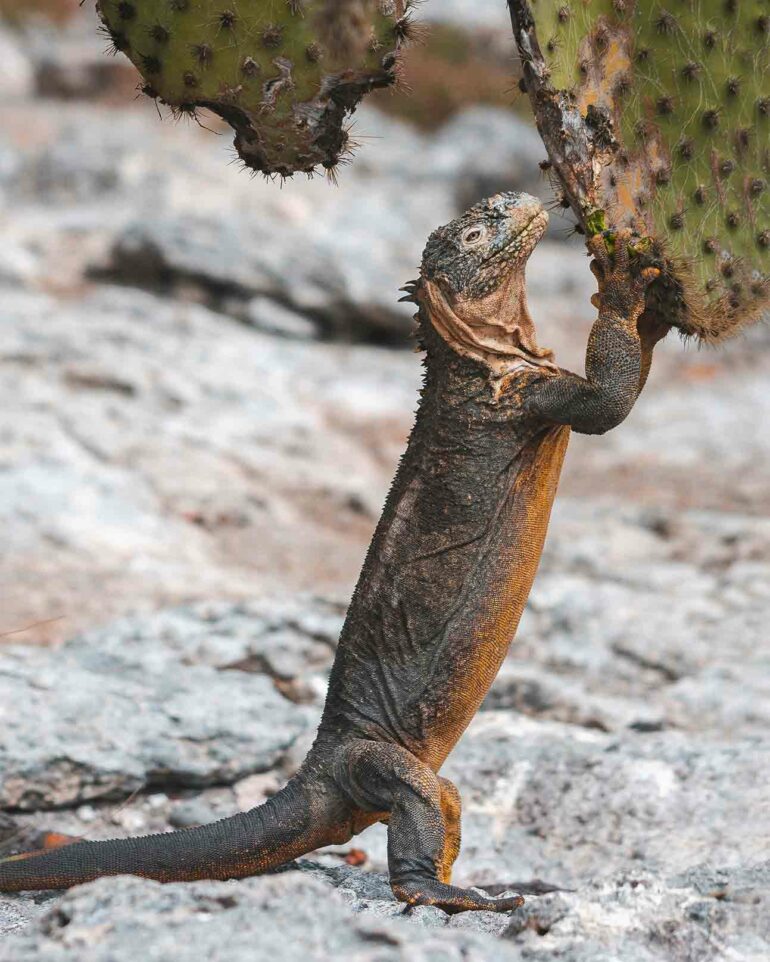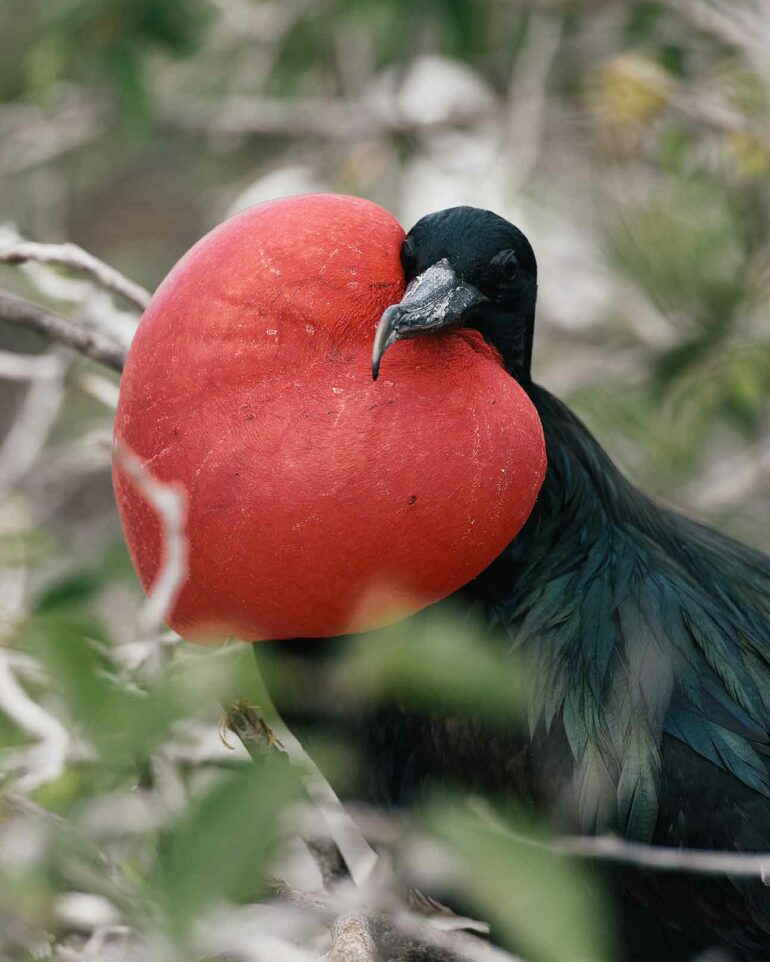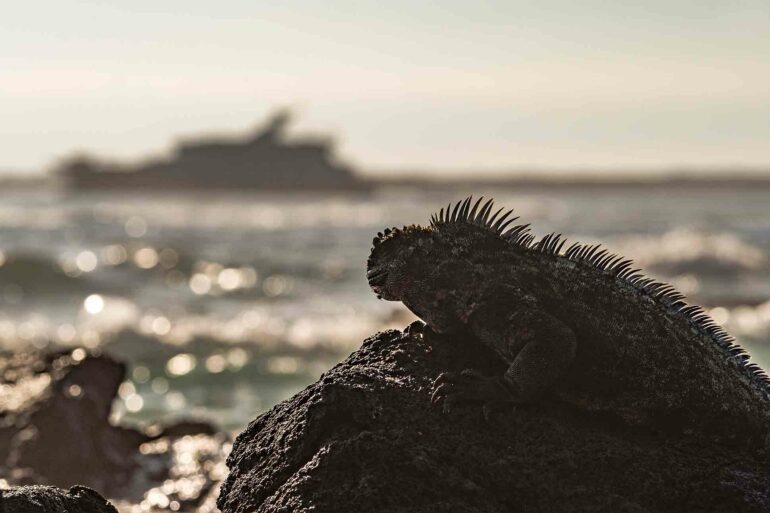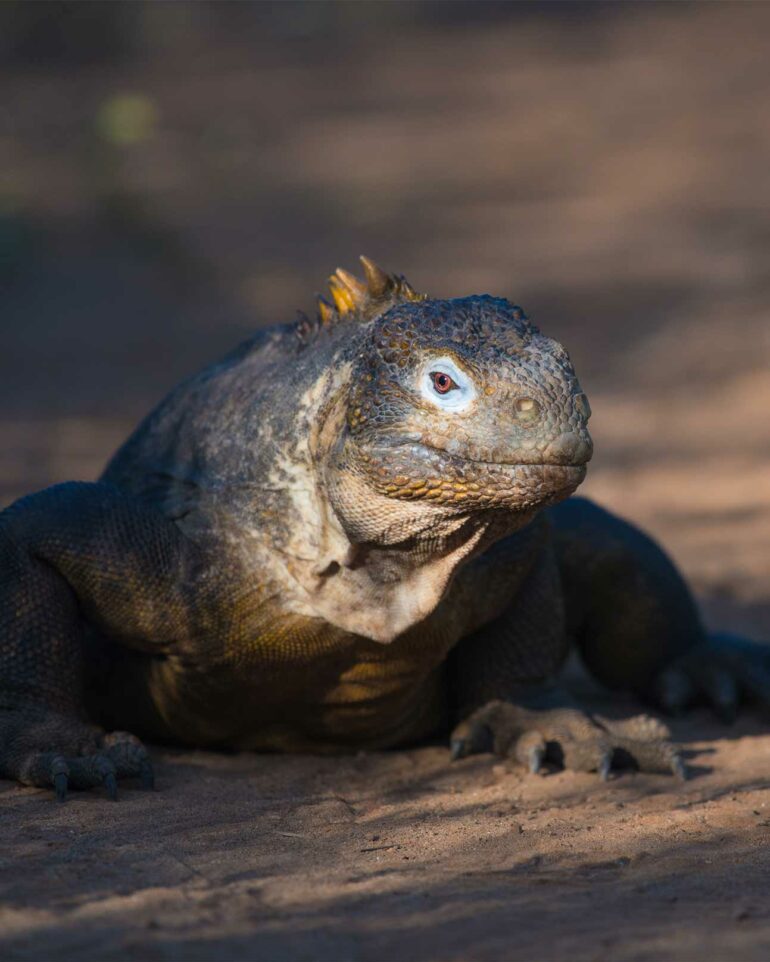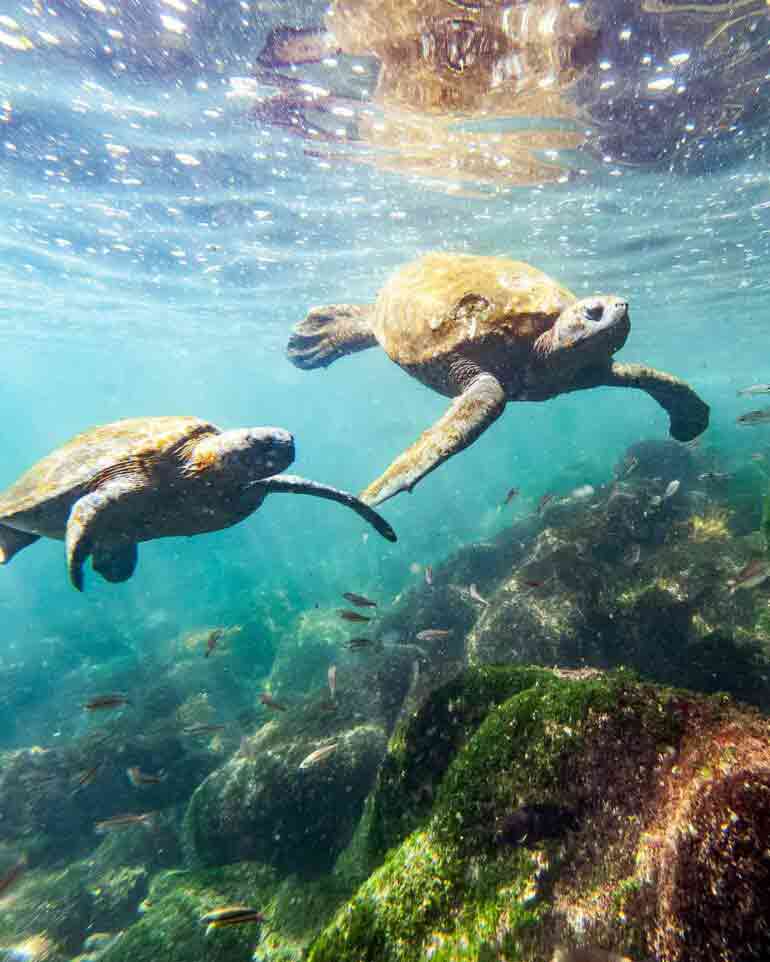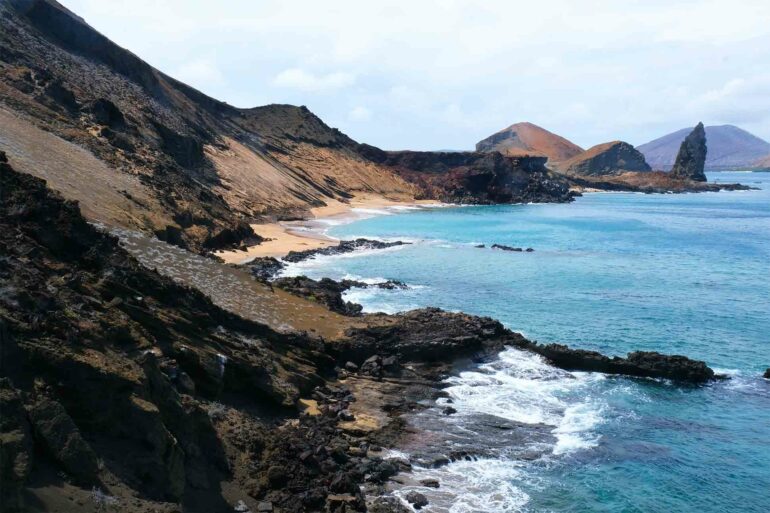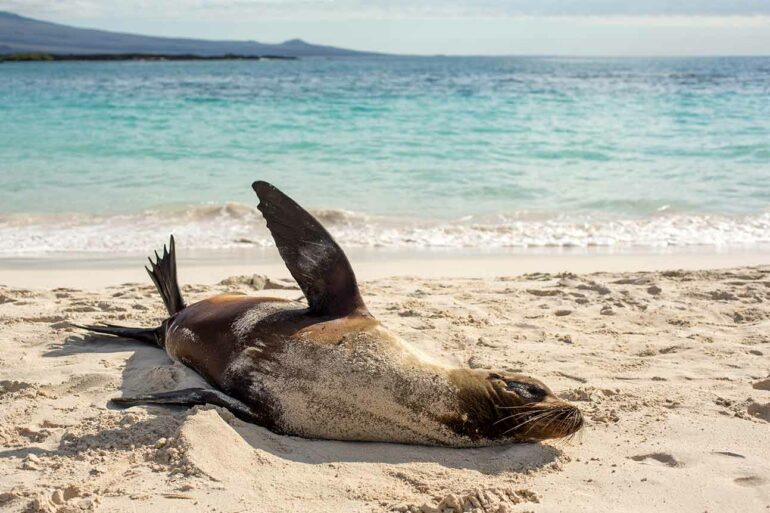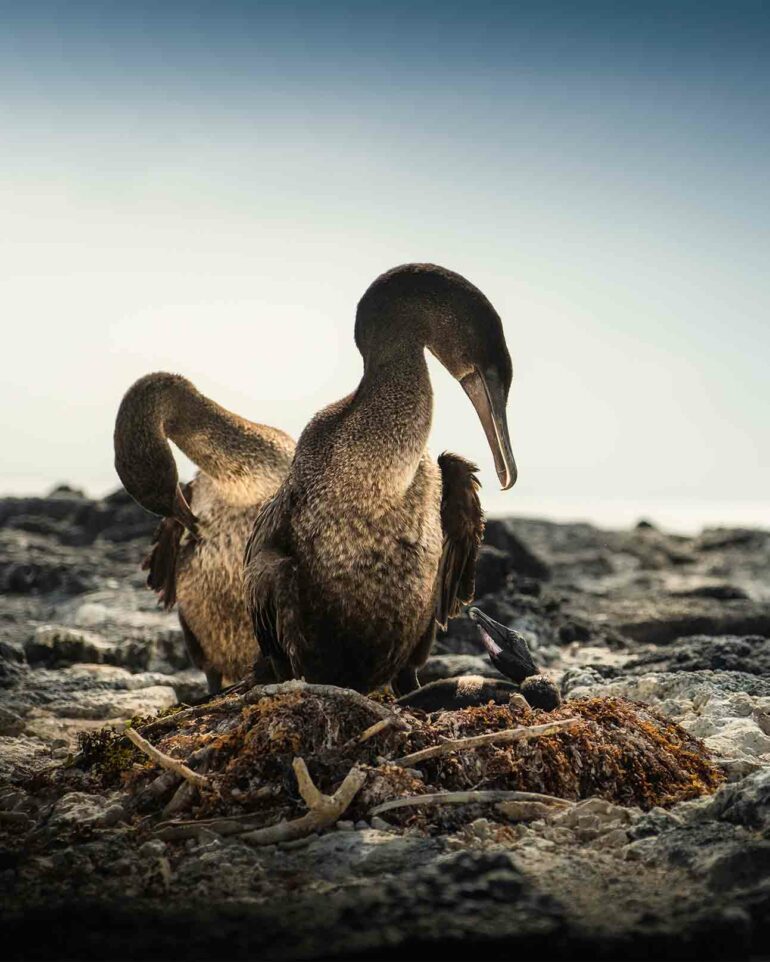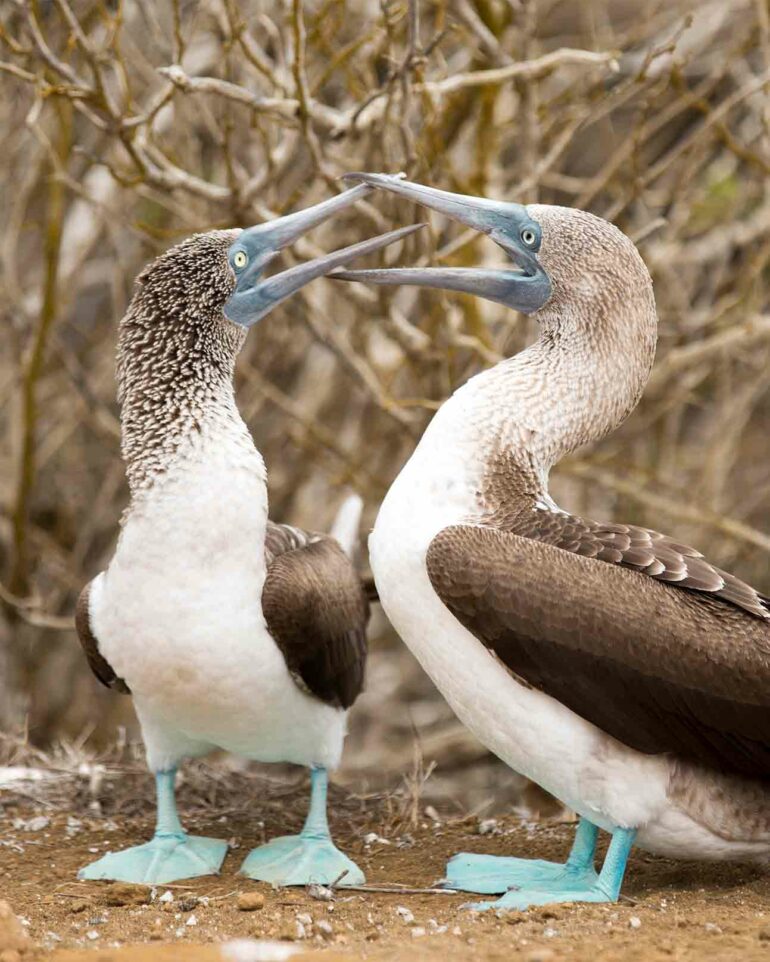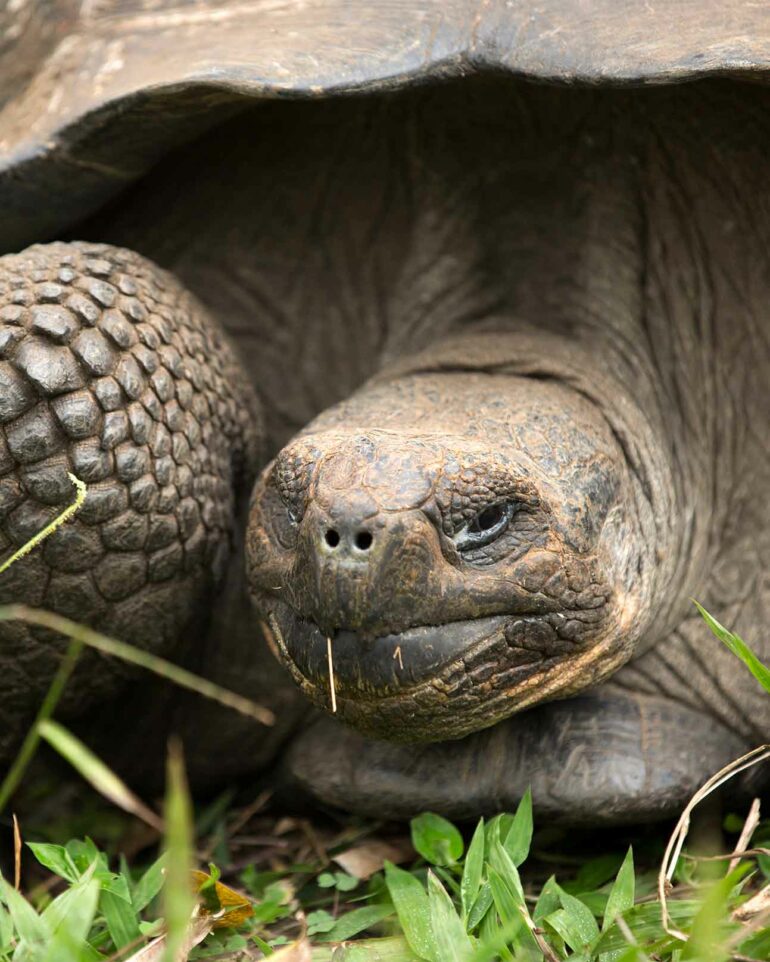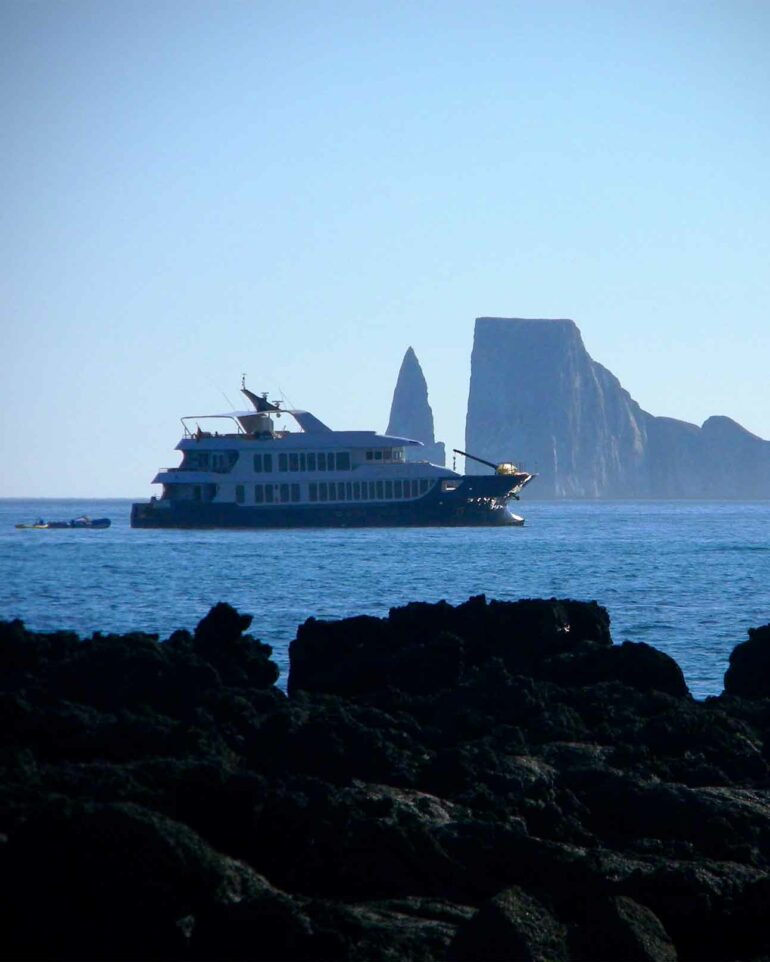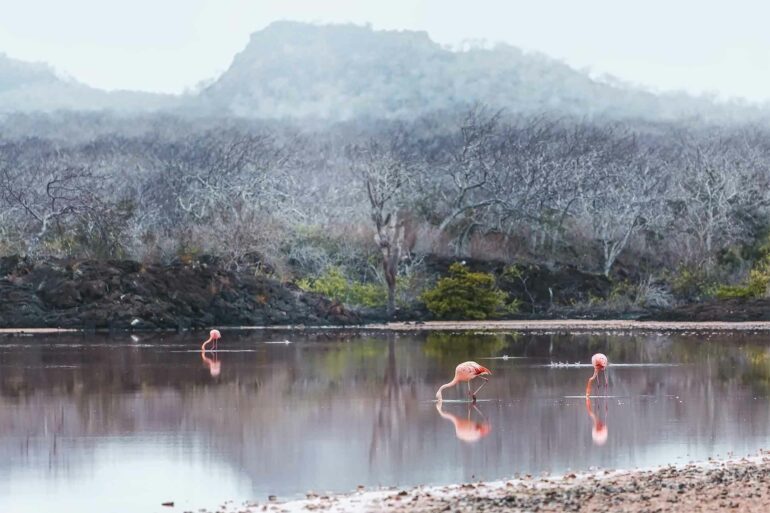For sightings of some of the most unusual wildlife on earth, a cruise around the Galápagos is a no-brainer. But for self-evolution? Uwern Jong hadn’t bargained on that.
It’s a glorious March day and the midday sun is beating down hard on the top deck of Ecoventura’s luxury expedition yacht Theory as we drop anchor in the bay just off Bartolomé Island. The weather here is characteristically balmy, especially at this time of year, I’m told, as we approach the spring equinox and the sun is directly above the equator. The clear sky seems somehow more infinite than it has over the past week I’ve been off land, our yacht just a small, bright, bobbing speck in the equally endless, mirror-like sea, divided from the sky only by the horizon and the breathtaking view of this island’s famous landmark Pinnacle Rock. This is picture-postcard Galápagos Islands: moody, rugged and raw in the shadows of its volcanic geology and glistening with hues of orange and green in the bright, equatorial sunshine.
I fancy myself as an intrepid explorer at large in Ecuador, a modern-day Charles Darwin, fresh off the boat – or rather on it. Except that Darwin didn’t have it this good when he first came here on the HMS Beagle nearly 200 years ago. As Galápagos expedition yachts go, Theory and the other members of the specialist Ecoventura fleet define luxury of the indulgent variety, especially when the water is this calm – the water in the Jacuzzi I’m lying in at the ship’s bow, that is.
Overhead, frigatebirds circle like pterodactyls, probably wondering what the bubbling human soup beneath them tastes like. Or perhaps they, too, fancy a warm soak. They get a little less interested when more humans appear on deck, but they don’t leave. They’re not afraid of us. That’s the beauty of wildlife here in the archipelago – they understand coexistence. I follow them in this life lesson as I crack a smile for my fellow passengers, who have now crowded around the hot tub to snap a picture of the island, destined no doubt for social media. I don’t blame them – between the scenery and this amazing yacht, there’s plenty to brag about to those at home.
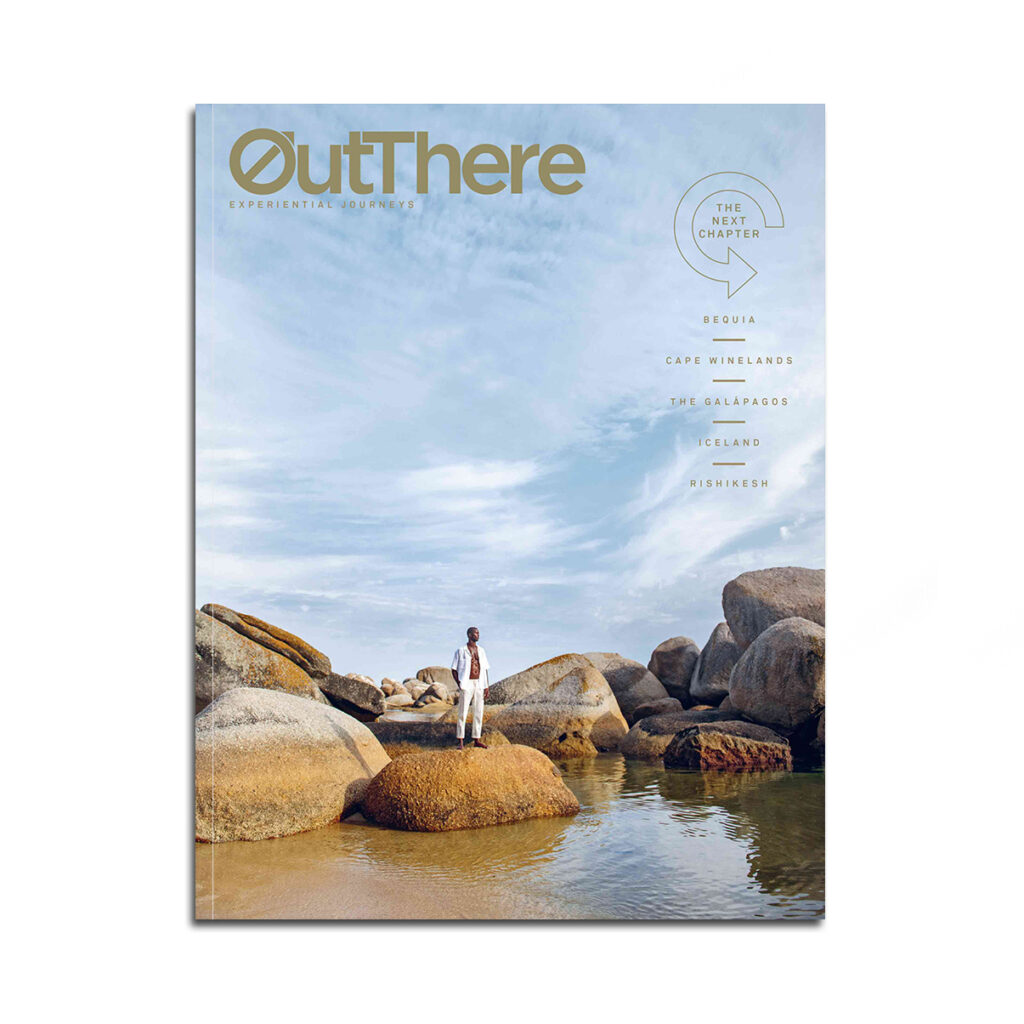
This story first appeared in The Next Chapter Issue, available in print and digital.
Subscribe today or purchase a back copy via our online shop.
I use the word ‘crowded’ loosely. On board are just 17 other explorers. My new friends. Like the Galápagos sea lions playing what looks like tag in the water and the penguins swept here from Antarctica by the Humboldt Current and now basking on a rock, my fellow adventurers and I are a collection of different ‘species’, from a variety of backgrounds all over the world. That’s the wonderful thing about small-ship cruising – beyond the unique and enriching experience of the expedition itself, sharing the wonders of the journey also offers an opportunity to get to know one another. A week ago we boarded as strangers. Now, it seems, we shall leave as forever friends.
Some of the party started their Ecuadorean journey like me, discovering the capital Quito, others by mooching around Guayaquil. Both cities are gateways to the wonderland that is the Galápagos. Eventually, we all made our way to sleepy San Cristóbal (aptly named after the patron saint of travellers) and, once on board our yacht, we meet our guides – Ceci, an effervescent Dora the Explorer-like character, and Billy, a huggable bear of a man.
Guides make or break a live-aboard journey. They’re with you all week, so they effectively have to be able to play both friend and host, as well as having an encyclopedic knowledge and being effortlessly entertaining. It’s also them you have to trust with your safety when you’re out on an expedition. No problem here, of course, as both are first-class, handpicked by Ecoventura as among the best at what they do. As the week progresses, it’s plain to see that they are both consummate guides who can also turn their hand to some fervent guitar strumming and belt out a hearty version of ‘Guantanamera’ to thrill and charm the troops or of ‘Iguana, ooh na-na’ to the tune of Camila Cabello’s ‘Havana’, which turns out to be the ear-worm of the trip.
“Only three percent of flora and fauna have diminished since the park opened back in the 1960s, a refreshing change from other ecological sites on the planet.”
We’re not going to straddle the equator on this journey. Unlike Ecoventura’s western and northern route, its southern and central itinerary means we never ‘cross the line’. Instead, the whole trip is designed to maximise the wildlife-spotting opportunities.
Sustainability is at the very heart of everything here on the expedition and I’m encouraged to hear that, despite tourism, only three percent of flora and fauna have diminished since the Galápagos National Park opened back in the 1960s, a refreshing change from what is happening on many other ecological sites on our planet. A lot of that is the result of the way tourism is managed here. Each expedition has strictly planned itineraries and only five groups of up to 16 people are allowed ashore on any island at one time. Yet, the danger of over-tourism remains a risk.
Ecoventura also plays its part. It’s held a Smart Voyager certification for over two decades. In fact, it was the first recipient of this voluntary ecological accreditation established by the Rainforest Alliance. More recently, the company’s vessels have partnered with the Charles Darwin Foundation and the Galápagos National Park Service to establish the Galápagos Biodiversity and Education for Sustainability Fund, which develops programmes that support projects related to biodiversity conservation, as well as providing education for the next generation of Galápagan biologists.
At the start of each day, I don my wetsuit and board a panga or Zodiac boat for an enthralling excursion. Circling Cerro Brujo (otherwise known as Witch’s Hill), I’m enchanted by the sheer volume of birdlife, an entire community of pelicans, terns and Nazcar boobies. Fluorescent Sally Lightfoot crabs scurry over the craggy volcanic rock, some rising up to create almost mystical geological formations. I jump off on to the smooth white-sand beach. All around me are marine iguanas (‘ooh na-na’) lazing in the sun. Huge sea lions are doing the same, albeit less discreetly, rolling around in the sand and barking a warm welcome as we wade ankle-deep in the shimmering, platinum sea.
I take a searing hike on Punta Pitt in search of the storied blue-footed booby. I find many, nesting peacefully. They stand as I approach, unashamedly lifting their feathered skirts like a burlesque dancer, tantalisingly showing their bright-blue feet. The conquistadors considered them clownish and clumsy (the name booby comes from the Spanish word ‘bobo’, meaning foolish or stupid), but they’re expert aerialists and swimmers, which goes a long way to demonstrate how being different can be amazing.
Landing on the island of Española, we look for the waved albatross, but sadly there aren’t many here yet at this time of year. They’re more likely to come to court between April and December, spending what seems like eons out on the open ocean. The marine iguanas here are different from the ones before. With algae as their diet, they’re bright red and green. Walking across the craggy landscape to a dramatic blowhole, I spot hundreds of different birds along the way – doves, finches, tropicbirds, mockingbirds, hawks and gulls. At Gardner Bay, on one of the most elegant beaches I’ve ever laid eyes on, I sift the cool white sand through my bare toes. That night, the stars come out to play, lighting up the night sky, just as the birds did during the day.
On Floreana Island, I spot stingrays dancing in the water, then watch flamboyant flocks of bright-pink flamingos wading in the brackish lagoon. The plant life here is equally fascinating – mangroves in a multitude of colours and endemic palo verde trees. At Devil’s Crown, I snorkel among colourful fish, oceanic whitetip sharks, starfish and enchanting giant sea turtles. The sea lions here are very playful, especially the pups. It helps them find their place in the world and develops their physical and cognitive strength. They’re insatiably inquisitive, demanding interaction in an adorable way. One swims close and smiles, as if waiting for me to point my camera at it, before showing off its underwater acrobatics.
On the populated island of Santa Cruz, I realise that I’m not alone out here in paradise. There’s a bustling harbour that’s a jumping-on point for daytrippers. It’s also home to the Galápagos Islands’ most well-known mascot, the giant tortoise. We come across a pair of these huge, slow-moving beasts mid-coitus and witness their evolution in progress. Theirs may not be the most effective example of reproduction – imagine two large, boulder-like creatures trying to mate – but since they live for centuries, I guess they have all the time in the world. Patiently and persistently, nature gets its way – a firm reminder that sometimes you just have to take things slow.
After a quick lesson in geology in some subterranean lava tunnels, I enjoy local human company back in town with the students who benefit from the Galápagos Biodiversity and Education for Sustainability Fund. I leave them content and reassured that the future will be in the hands of some young truly switched-on human beings.
I can’t actually remember another trip when I’ve spent so much time in the water, not just in the hot tub, but actually in the sea. Here, near Bartolomé, I’m going to get up close and personal with the penguins we spy in the shadows of Pinnacle Rock, with the promise too of spotting some hammerhead sharks. The thought of equatorial penguins is absolutely nonsensical, but there they are. They’ve adapted to the heat by becoming much smaller than their ancestors and developing the ability to regulate their body temperature.
A strenuous hike to the very top of the island is to follow. It is said to be the most spellbinding view in the Galápagos. Tomorrow, we cruise to South Plaza Island to see Darwin’s prickly pear cacti and the yellow land iguanas that hug them for their moisture. We’ll also head to North Seymour to witness those dinosaur-like frigatebirds, with their inflatable scarlet throat sacs.
“This natural order of the world seems all the more poignant in these times.
I resolve to go forward with my glass half full, rather than defaulting to complaints.”
Reflecting on my time here, it dawns on me that, beyond the enjoyment of this luxury expedition cruise, I’ll go home with some amazing life lessons. From the swarms of birds (and my fellow passengers), I’ve learnt the power of community, coexistence and camaraderie. From the playful sea lions, I’m reminded to find more fun in my adult life, to indulge my guilty pleasures now and again and to expand my creativity and imagination. From Santa Cruz, I realise that patience is a virtue. From the penguins, I contemplate the notion of ‘adapt or die’. This natural order of the world seems all the more poignant in these times. I resolve to go forward with my glass half full, rather than defaulting to complaints about the way things are.
Moreover, my time in the Galápagos has reinforced the power of travel in broadening horizons and drawing unique perspectives on life. Yet more importantly, it’s also taught me lessons in resilience, overcoming adversity and even thriving in the most challenging of scenarios. Pachamama, as they call Mother Earth here, doesn’t always play nice, but it is how you adapt and come out of the other side of events – stronger and oftentimes more colourful than before – that really matters.
Uwern travelled with Scott Dunn, who offer a seven-night Galápagos cruise on Ecoventura’s Theory or Origin yachts, including international and domestic flights, private transfers in Quito, dining and activities. Also included are three nights at Casa Gangotena and Illa Experience Hotel in Quito, a tasting experience at Terra restaurant, a Quito city tour and Ingala card and Galápagos National Park fees. You can book Ecuador, Latin America and more at www.scottdunn.com/outthere. Ecoventura also has special experiential sailings, from photography to deep-dive ecology and wellness.
Photography courtesy of Ecoventura, by Renato Granieri, Yolanda Escobar Jiménez, Matt Dutile, Harry Skeggs, Martin Tychtl via www.laidbacktrip.com, Nathalie Marquis via Unsplash and www.travelleap.co
Get out there
Do…
… bring an underwater camera or GoPro – you’ll want to use it lots. But double-check if you need a separate case to keep the water out – splash-proof is different from submersible.
…put the Galápagos at the end of a busy South American trip. While the cruise itinerary is packed, there is plenty of time to rest between excursions and the weather is delightful.
…consider staying on a few days if you like scuba diving. At the end of your week’s introduction to the Galápagos, Ecoventura runs scuba live-aboards on a 16-passenger luxury vessel that will give you a whole different perspective.
Don’t…
…forget to pack plenty of memory cards or bring a large hard drive. There are photo and video opportunities galore and you will run out of space otherwise.
…think you can land on every island in bare feet – some places are rather craggy. Pack sturdy waterproof footwear (flip flops won’t cut it). Second-skin expedition socks are what those in the know bring.
…miss the elusive Galápagos passport stamp. There is one and it’s one of the world’s most collectable. But because you’re on a domestic flight, you won’t automatically get it. So, if you want one, ask for it. Por favor…
The inside track

Sinead Somers is Americas expert at award-winning luxury tour operator Scott Dunn, which has been creating tailor-made holidays and honeymoons to amazing destinations all over the world for more than 30 years.
Chill
You’ll never get to see the whole of the Galápagos, so don’t worry which islands you do or don’t visit. Every one of them promises bountiful wildlife and unforgettable experiences. We guarantee that you will not come home feeling short changed.
Plan
If you suffer badly from sea sickness, you might want to think about which time of year you choose to visit. The Galápagos Islands are a year-round destination, but you may wish to avoid the misty windier garúa season that starts in June and lasts until November.
Cruise
This may sound like a given, but many people ask us if you can do the Galápagos on land. Yes, you can, but honestly there is nothing like being on an Ecoventura cruise. For one thing, it allows you to travel much further afield, with long distances undertaken as you sleep.


